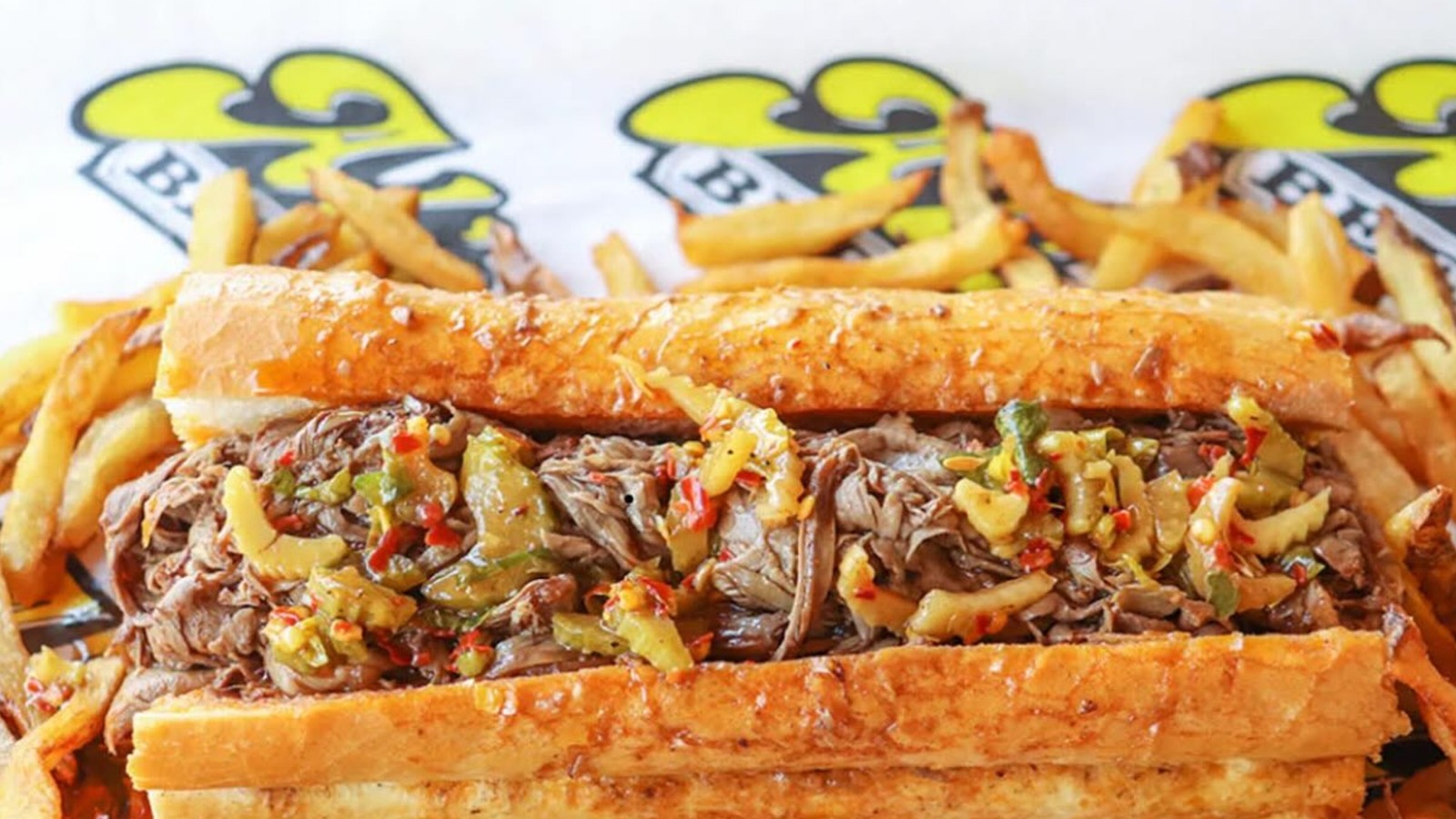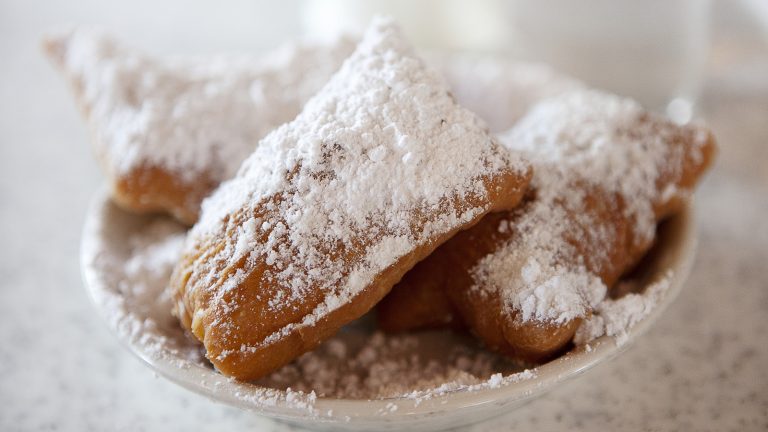It’s not as famous as deep-dish pizza, but if you spend much time in Chicago you will run into the legendary Italian beef sandwich. Not to be confused with a French dip or Philly Cheese Steak, this is an entirely Chicago creation born of Italian American immigrants looking for a way to stretch out their meat, and coming up with an amazingly delicious solution. Rich and flavorful, an Italian beef sandwich is sliced paper-thin and piled high atop a hearty French or Italian roll. Top it off with peppers (hot or sweet) and a ladleful of au jus (also called gravy) made straight from the pan drippings.
Italian beef is one of those regional dishes that can be hard to find done well outside of its local area. Though it’s gained popularity nationwide, thanks to FX’s “The Bear,” this Chicago creation is still mostly confined to Chicagoland. Any Chicago-catered event will likely have an Italian beef station alongside Italian sausages, pizza, and a tray of baked mostaccioli. But just what makes Italian beef so special? Read on for the juicy details.
An Italian beef sandwich is not the same as a roast beef sandwich or Italian sub
Although the Italian beef sandwich is incredibly popular in Chicago and the suburbs, it can be nearly impossible to find a correctly made one if you venture far from Chicagoland. People who have never heard of an Italian beef sandwich may think it’s a cold-cut sandwich filled with deli meats. Or perhaps a roast beef sandwich with Italian seasoning. It’s none of those things, but something entirely unique. Outsiders may confuse it with an Italian sub. Italian subs, filled with Italian cold cuts like capicola, salami, and prosciutto, originally hail from Portland, Maine. They can be found in just about any sandwich shop in the country, although some do it better than others.
An Italian beef sandwich is also not the same thing as a roast beef sandwich. Roast beef is often made with thicker cuts that may be pinkish in the middle. Slices of roast beef have a bit of chewiness, and the sandwiches are classically served with horseradish. Experts recommend lean cuts of beef for roast beef, but Italian beef should be made with a fatty roast, like a chuck roast. Because it’s a tough, fatty, cheaper cut of meat, Italian beef is cooked low and slow to get a tender, juicy, fall-apart meat.
Controversy surrounds the exact origins
You can’t talk about the history of Chicago’s Italian beef sandwich without talking about Al’s #1 Italian Beef. The story begins at the end of WWI. Anthony Ferreri, a Chicago street peddler, sold sandwiches and bakery items around the city. Anthony had a brilliant idea one day while attending a local Italian-American peanut wedding. Italian American immigrants didn’t have much money, so weddings were frugal events. The hosts would serve cheap food to the guests, such as peanuts, hence the name, peanut wedding. At this wedding, Ferreri noticed the family was serving thick cuts of roast beef on bread. Anthony realized he could get meat to stretch a lot further if he sliced it very thin. His thinly sliced beef sandwiches were a hit, and in 1938, Anthony’s son, Al, opened a family beef stand in Little Italy. Today, the shop is known as Al’s Beef with three locations in Chicago.
The story might end there, but things aren’t usually that simple in Chicago. There is some controversy over who the real inventor of the Italian beef sandwich might be. Another Italian immigrant, Pasquale Scala, sold thinly sliced beef on buns loaded with gravy at the end of WWI. Although we don’t know for certain who the original inventor is, we do know both men were selling thinly sliced beef sandwiches in the early 1900s. Both likely had a role to play in helping the sandwich to become more widespread across Chicago.
It wasn’t until the 80s that Italian beef exploded nationwide
After the 1930s, when Al’s Beef opened a shop, Italian beef sandwiches grew popular in Chicago neighborhoods. Vendors and sandwich shops cropped up around the city selling the Italian beef. However, it wouldn’t be until the 1980s when the Italian beef sandwich hit the national stage. Chicago Magazine named Al’s Beef the #1 Italian Beef Sandwich in Chicago. Thie business became a hit and change its name from Al’s Beef to Al’s #1 Italian Beef.
Later in the decade, in 1989, Jay Leno appeared on “Late Night with David Letterman,” with a bag of Italian beef sandwiches from Mr. Beef, a Chicago staple located on North Orleans Street. As Leno chatted with David Letterman, he ate three sandwiches, leading Dave to joke, “I hope I don’t have to Heimlich you later on.” This turned out to be a great commercial for Mr. Beef and helped bring Italian beef to the nation.
The Bear revived its popularity
Jay Leno may have brought a national spotlight to Italian beef in the 1980s, but “The Bear” brought it center stage today. The FX on Hulu series is about a chef in Chicago who runs his family’s Italian beef sandwich shop. The show’s shop was based on the real shop, Mr. Beef (the very same shop where Jay Leno got his sandwiches from), and it has so popularized Italian beef today that the Los Angeles Times has even published a recipe for “The Bear” Italian Beef Sandwich.
This popularity has led those who love the sandwich for its messy simplicity to worry, will the rest of the world ruin the humble Italian beef? Will someone in New York or Los Angeles attempt to make it artisanal or gourmet? As every Chicagoan knows, the best way to eat this shirt-ruining food is wrapped up in waxed paper as the gravy drips down your hand, preferably as you sit in your home or on a bench outdoors, certainly not in a fancy restaurant.
There are a few things you need to know before you order
So you’ve made it to Al’s Beef, Mr. Beef, or another Italian beef shop in the city and you are faced with ordering your sandwich with a line of hungry people behind you. There are a few things you need to consider before you order. First, do you want it wet, dry, or dipped? The Italian beef is cooked in a flavorful beef broth. You can yours with the beef “dry” where it’s pulled out with tongs and left to drip before going in your sandwich. Or you can get it wet, where the juicy beef is placed in the sandwich, and often a spoonful of broth is poured over it. Finally, dipped means the entire sandwich gets dipped into the broth. If you go the dipped route, we recommend eating it immediately; don’t plan on bringing this one home.
Once you’ve figured that out, you must decide between hot or sweet. This refers to the peppers. When you order sweet, your sandwich will be topped with roasted green or red bell peppers. Order it hot, and you will receive a generous dollop of hot giardiniera. This is an Italian relish with pickled, sliced hot sports peppers and other vegetables. If you want cheese, you have to ask, and it’s not traditional, but always an option.
Cheese is not a standard topping
If you order your Italian beef with cheese, you will likely get a thin slice of mozzarella or provolone that will melt into the hot meat and juices. Some places may brown it under a broiler, but this isn’t a necessary step. Unlike the faux pas of ordering ketchup on your Chicago hot dog, it is usually acceptable to get your beef with cheese. However, it’s not how the sandwich was traditionally made.
There is a variation at Portillo’s, a popular Chicago-based Italian beef and hot dog chain, in which the same melted cheddar cheese sauce used for dipping French fries is poured on top of an Italian beef sandwich. Some variations call for the meat and cheese on a croissant rather than the traditional sub sandwich bread. But now, of course, you have something different from an Italian beef sandwich, a beef and cheddar croissant, although it does use the same meat.
It’s hard to get a true Italian beef outside of Chicago
One issue in finding Italian beef outside of Chicago can be a misunderstanding of what Italian beef truly is. However, even if you know how to make the perfect Italian beef sandwich, it can get tricky to find the proper ingredients outside of Chicagoland. While the meat isn’t hard to replicate, the bread is critical. You need bread that can stand up to the juices, or you will end up with a wet, soggy mess topped with meat. Traditionally, the sandwiches are made with a roll of French bread. It can’t be high-quality French bread, because the crust is too hard. Nor do you want a soft French bread roll. Around Chicago, you can find commercially baked French or Italian rolls made by Turano or Gonella baking companies. But outside of the city, it can be hard to come by, though you may have luck finding Turano bread online.
Another Chicago staple is the sweet and hot peppers. If you like your sandwich sweet, you can roast bell peppers for topping. But it can be hard to replicate the hot when looking for hot giardiniera. One brand you will find in Chicago stores is Marconi. But, this may be hard to get around the country, although it is sold online.
The Italian beef combo is not a value meal
Outsiders would be forgiven for thinking an Italian beef combo comes with fries and a drink. But that isn’t what a combo is at all. When you order an Italian beef combo, you will get an Italian beef sandwich. And on your sandwich, along with the meat and toppings, will be a full-sized Italian sausage. Sometimes you will see them on menus as Italian beef combos, or sometimes you will just see it listed as a combo. That means it will always be a sausage and Italian beef together in the same bun.
While we can trace the original Italian beef sandwich to the early 1900s, it’s much harder to pinpoint the origin of adding sausage on the beef sandwich. But today, wherever you can buy an Italian beef, you can likely order a combo. However, be sure you have a big appetite before you try this Chicago wonder.
You can make it at home
Italian beef is surprisingly easy to make at home. You can find many recipes with an online search. Or you can check out a traditional recipe in a Chicago Tribune article from 1990. This recipe uses a sirloin tip roast, which varies from the usual chuck roast in many recipes. The meat is seasoned with Italian spices and baked in the oven. The sauce comes from pan juices in which the fat is discarded.
If you want the slices as thin as Anthony Ferreri’s original beef sandwich served up at peanut weddings, you will need to freeze the cooked beef until it’s solid for easier slicing. You can get the best results with a meat slicer or an electric knife. Once you’ve got your paper-thin slices sitting nestled inside the flavorful pan juices, you will need proper bread (Italian or French rolls) and either roasted bell peppers or hot giardiniera. The best way to serve it is with a side of crunchy French fries.
Locals argue where to get the best Italian beef sandwich today
Asking a Chicagoan where to get the best Italian beef can give you multiple answers. Of course, there is the original Al’s #1 Italian Beef on Taylor Street where it all began. Mr. Beef, made famous by “The Bear” and Jay Leno, is also a top contender. Johnnie’s Beef in Elmwood Park is another local favorite. This tiny sandwich shop has long lines forming around the building. The list wouldn’t be complete without Tony’s Italian Beef with its housemade giardiniera. Other famous shops include Roma’s Italian Beef & Sausage, Bob-O’s Hot Dogs, and Novi’s Beef in Berwyn.
This is nowhere near a complete list, but we also must talk about the suburbs where the big chain restaurants are located, which may be your only choice for Italian beef if you are stuck far out in the ‘burbs. Portillo’s and Buona Beef have both their fans and their critics. Portillo’s began in the 1960s as a hot dog stand, but today it is a public company located outside of Chicago. Buona Beef is a family-owned restaurant that started in 1981 and today has over 25 locations, mainly around Chicago. Though many locals would not recommend either chain for the best Italian beef ever, both restaurants offer warm, meaty, and juicy sandwiches, which admittedly, taste a lot better with lots of au jus and a generous topping of hot giardiniera.





